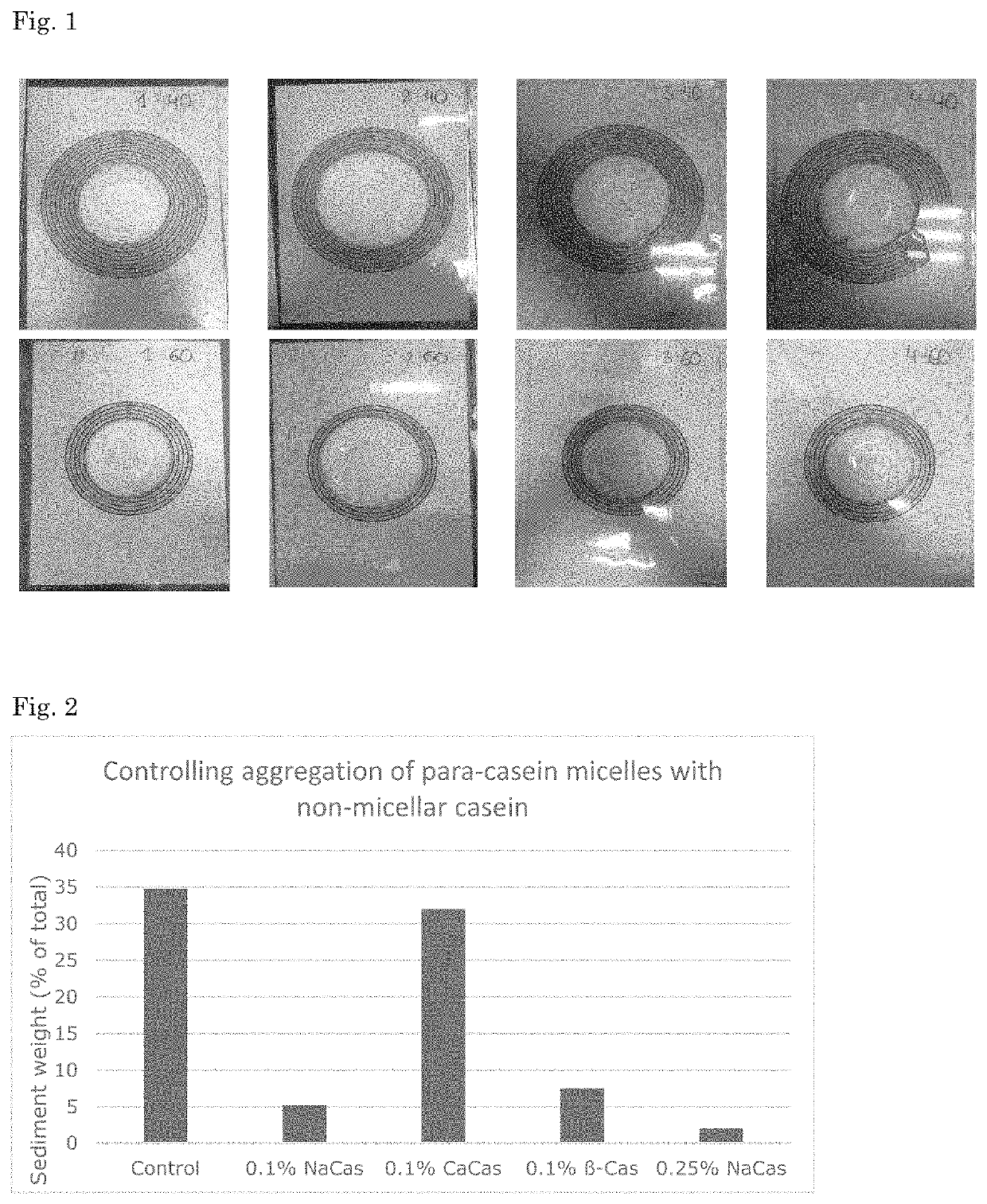Method for producing cheese
- Summary
- Abstract
- Description
- Claims
- Application Information
AI Technical Summary
Benefits of technology
Problems solved by technology
Method used
Image
Examples
example 1
Addition of Caseinate Reduces Gel Strength of Casein-Enriched Cheese Milk
[0064]A cheese milk enriched in micellar casein was prepared by mixing 125 g of water, 280 g Skim Milk and 645 g Full Cream Milk. The mixture containing ˜2.5 wt % of micellar casein was preheated to 50° C. Each of 3 beakers was filled with 350 grams of this mixture, and 2.0 g of CaCl2 was added to each beaker.
[0065]1.0 g of Sodium Caseinate was added to beaker 2 and 1.0 g of Calcium Caseinate was added to beaker 3.
[0066]The resulting blend was cooled down to temperature of 35° C. and agitated for 10 minutes to ensure homogeneous distribution of all ingredients.
[0067]2.0 g of rennet (1:9 dilution of Kalase—Calf Rennet, CSK) was added to each beaker and agitated for another 5 minutes. The contents of each beaker was evenly distributed over 5 equally sized and shaped cups. Coagulation was allowed under controlled temperature of 35° C.
[0068]After 40, 50, 60, 70 and 80 minutes respectively, one cup was turned on a S...
example 2
Addition of Whey Comprising Caseinate Reduces Gel Strength of MCI-Enriched Cheese Milk
[0070]1200 g MCI (Micellar Casein Isolate—MCI80TL from FrieslandCampina DOMO factory in Lochem) and 428 g Cream (40% fat) were separately preheated to 50° C. and then mixed to a micellar casein content of ˜10%.[0071]4 beakers were filled each with 407 grams of this mixture.
[0072]Two 2 different types of “whey” were prepared:[0073]a. Regular cheese whey diluted with water to 2% w / w of lactose[0074]b. Regular cheese whey diluted with water to 2% w / w of lactose to which 2% of CMP was added.
[0075]The whey preparations were heated to 50° C. Then:[0076]To the first beaker 644 g of diluted cheese whey as prepared under a. was added.[0077]To the second beaker 644 g of CMP-whey as prepared under b. was added.[0078]To the third beaker 644 g of diluted cheese whey as prepared under a. was added. Also 1.0 g of sodium caseinate was added.[0079]To the fourth beaker 644 g of diluted cheese whey as prepared under ...
example 3
Controlling Aggregation of Para-Casein Micelles with Non-Micellar Casein
[0086]The following procedure was followed:[0087]MCI was dissolved to 3.5% w / w protein in Milk Permeate.[0088]To 5 test tubes was added:
[0089]Nothing—control
[0090]0.1 w% sodium caseinate
[0091]0.1 w% calcium caseinate
[0092]0.1 w% B casein
[0093]0.25 w% sodium caseinate[0094]The content of each tube was renneted for 75 minutes at 30° C.[0095]Next the test tubes were centrifuged 10 minutes at 2000 g.[0096]The sediment weight was determined.
[0097]As shown in FIG. 2, it was observed that:[0098]a) Significantly less sediment was formed in each sample compared to the control. Sodium caseinate was more effective than ß-casein, which in turn was more effective than calcium caseinate.[0099]b) Increasing the amount of sodium caseinate further reduced the amount of sediment formed.
PUM
 Login to View More
Login to View More Abstract
Description
Claims
Application Information
 Login to View More
Login to View More - R&D
- Intellectual Property
- Life Sciences
- Materials
- Tech Scout
- Unparalleled Data Quality
- Higher Quality Content
- 60% Fewer Hallucinations
Browse by: Latest US Patents, China's latest patents, Technical Efficacy Thesaurus, Application Domain, Technology Topic, Popular Technical Reports.
© 2025 PatSnap. All rights reserved.Legal|Privacy policy|Modern Slavery Act Transparency Statement|Sitemap|About US| Contact US: help@patsnap.com

